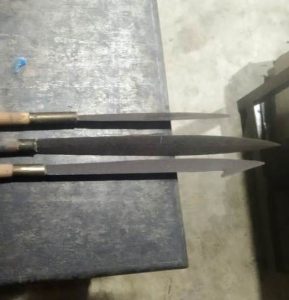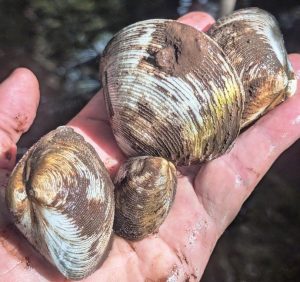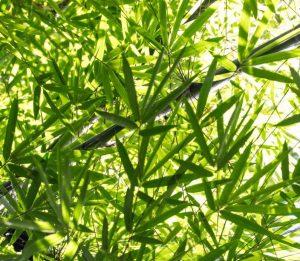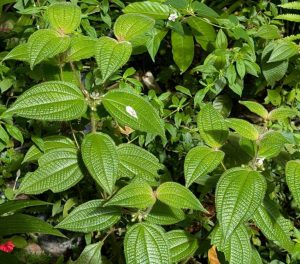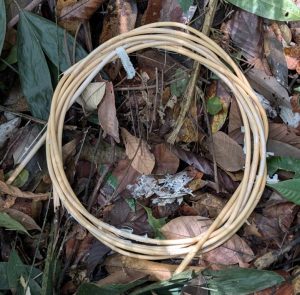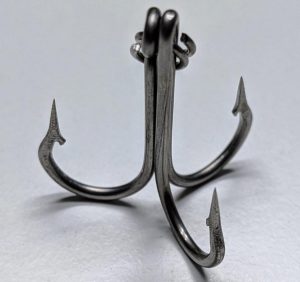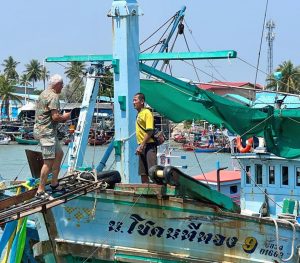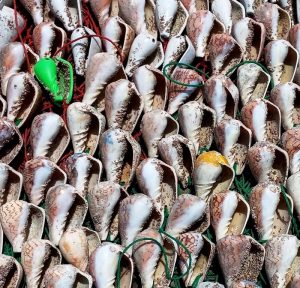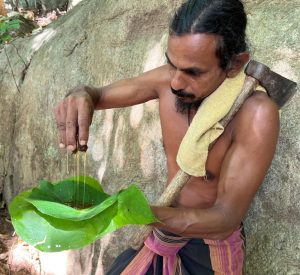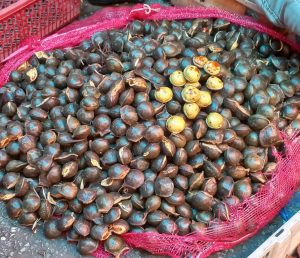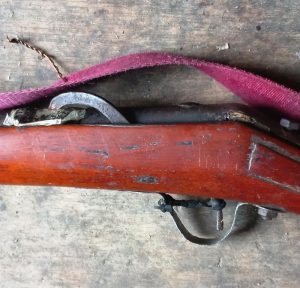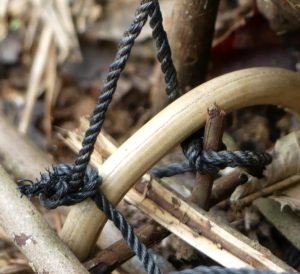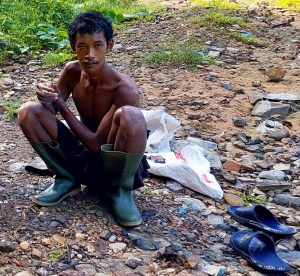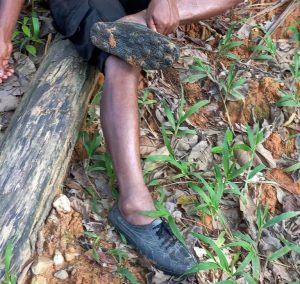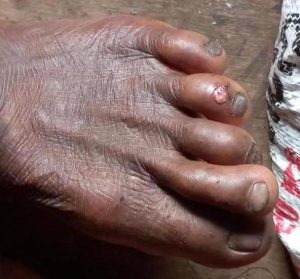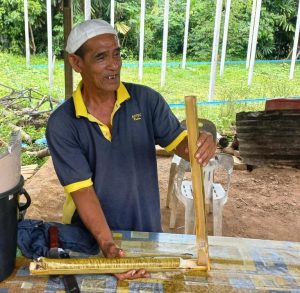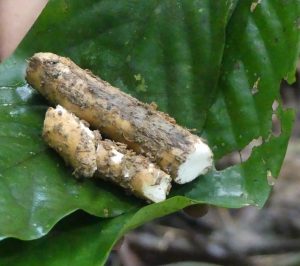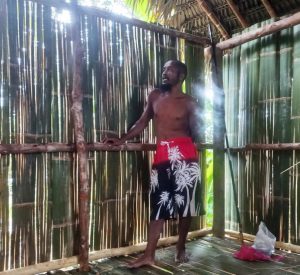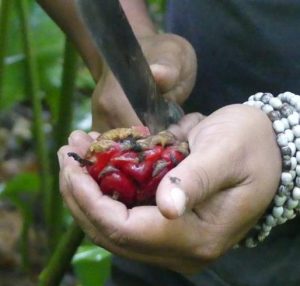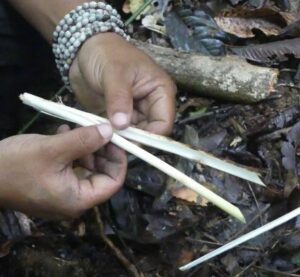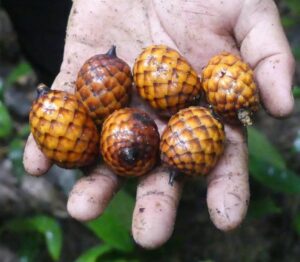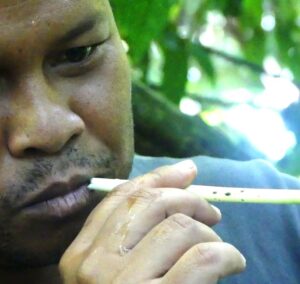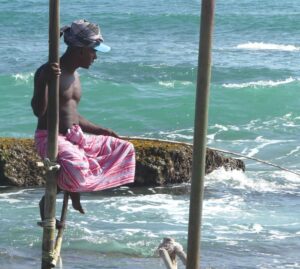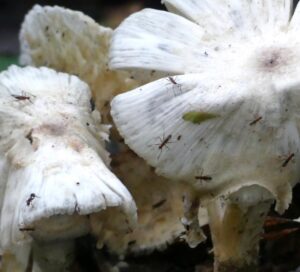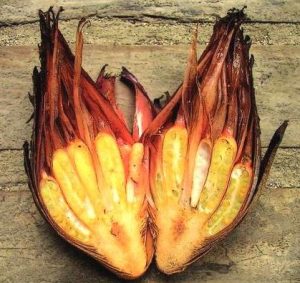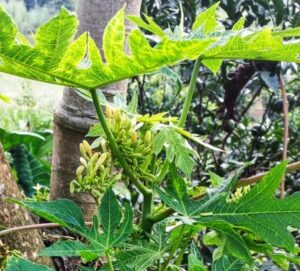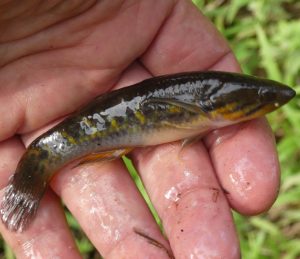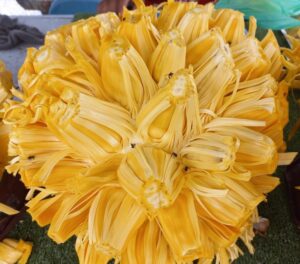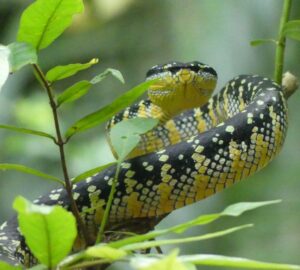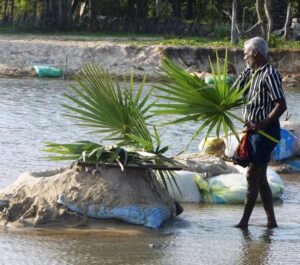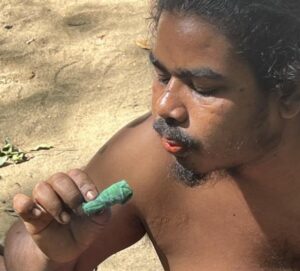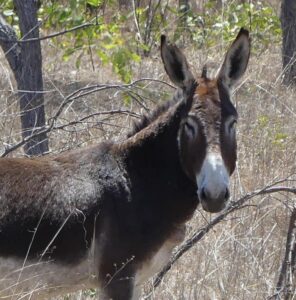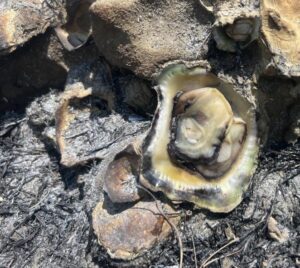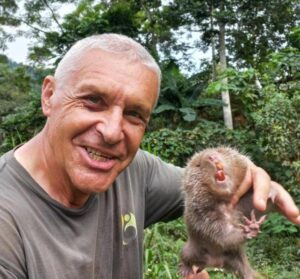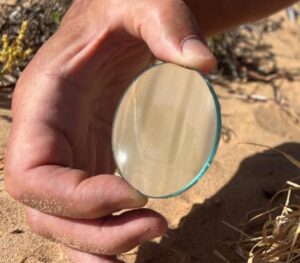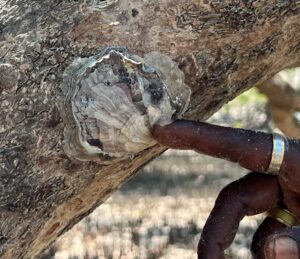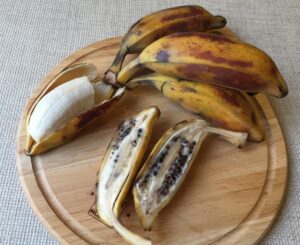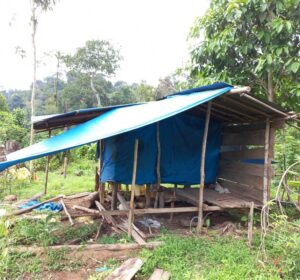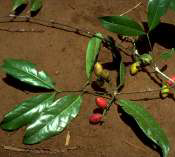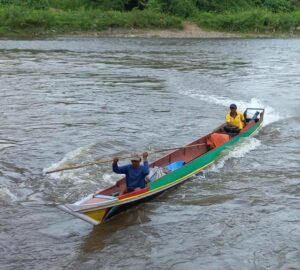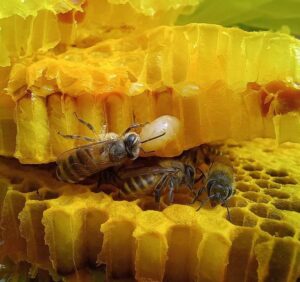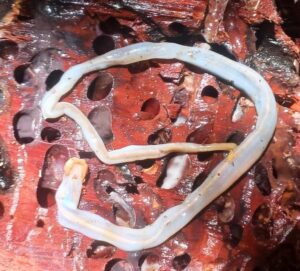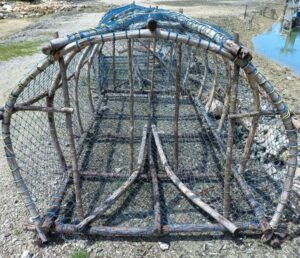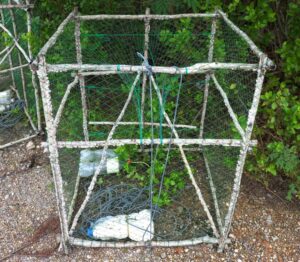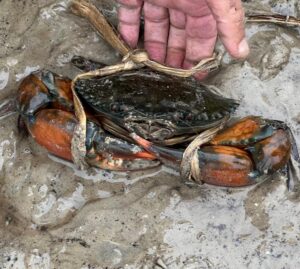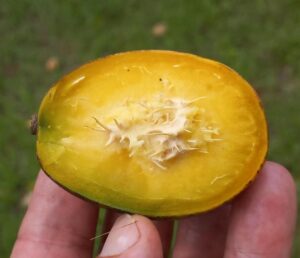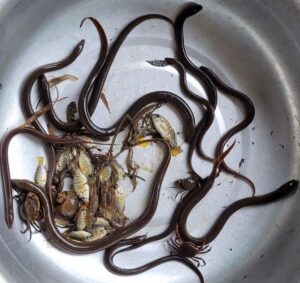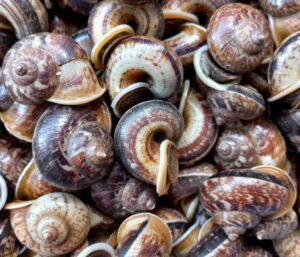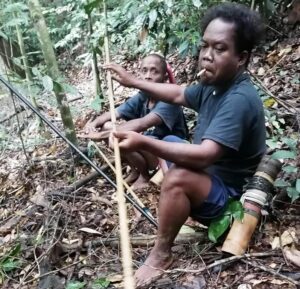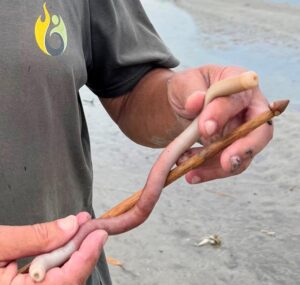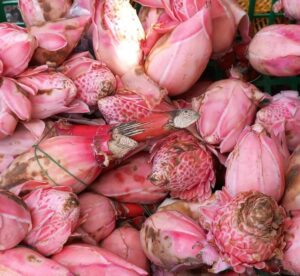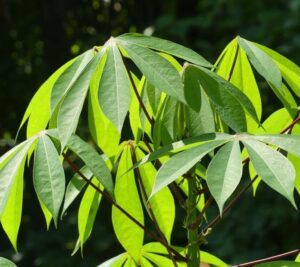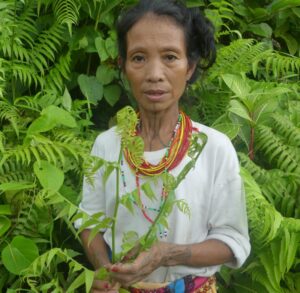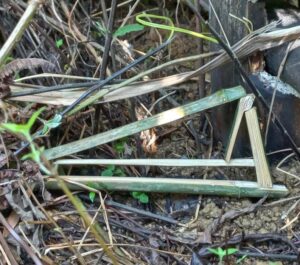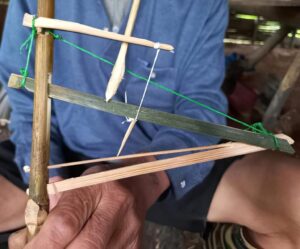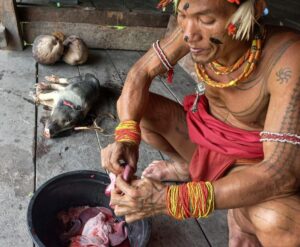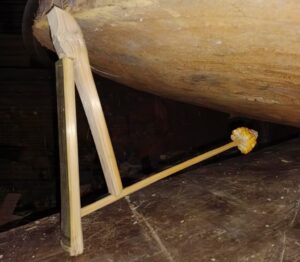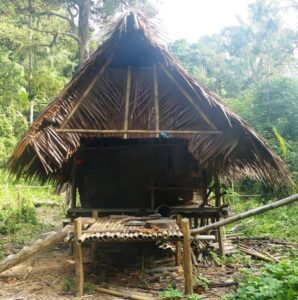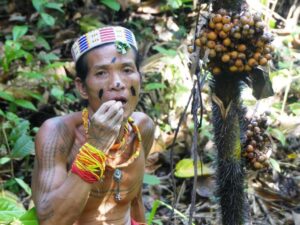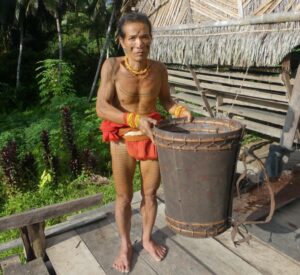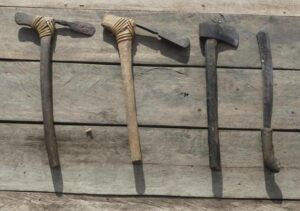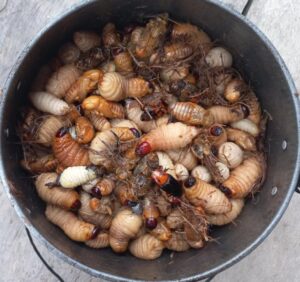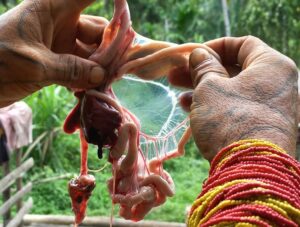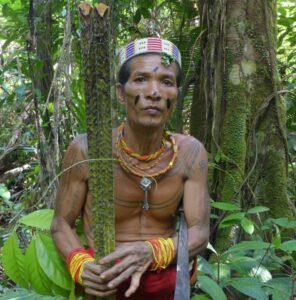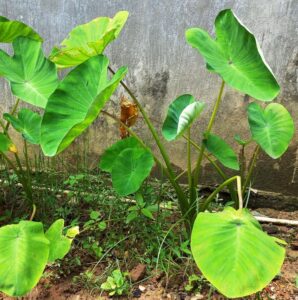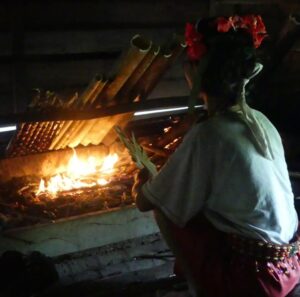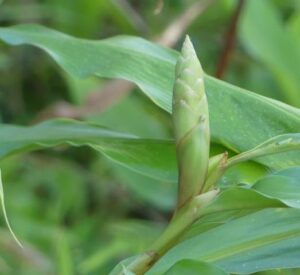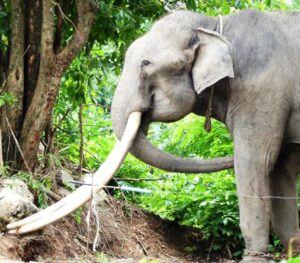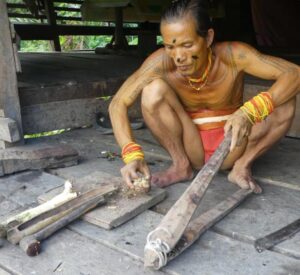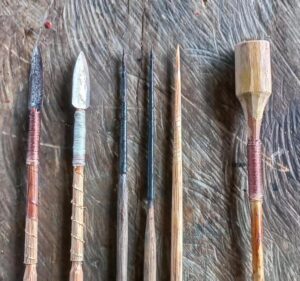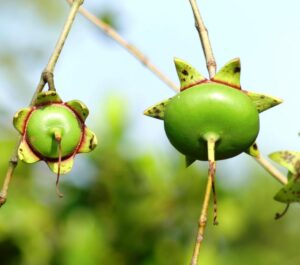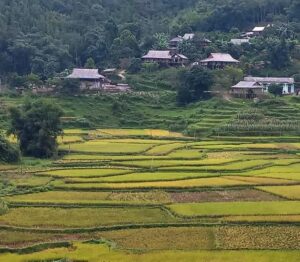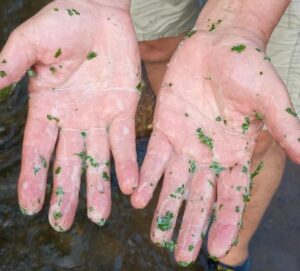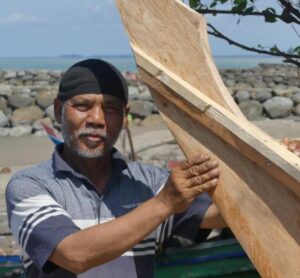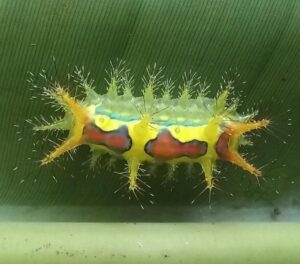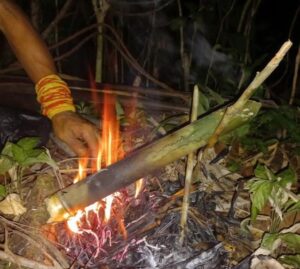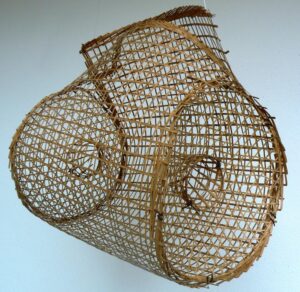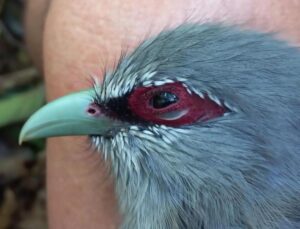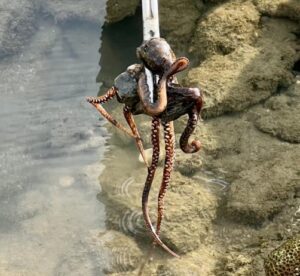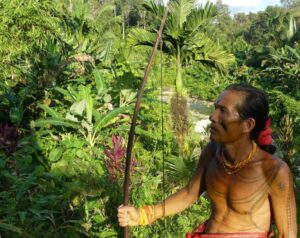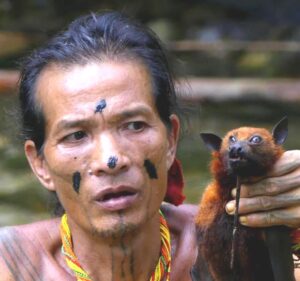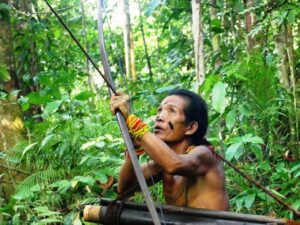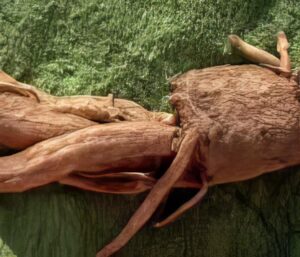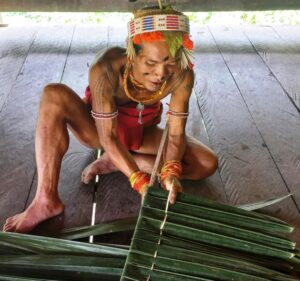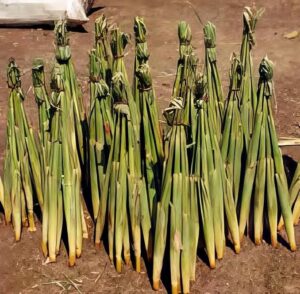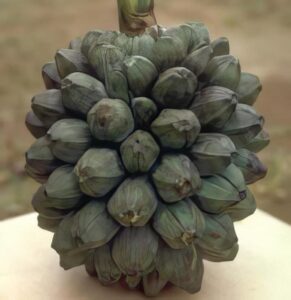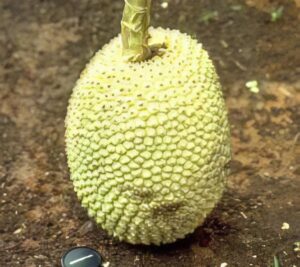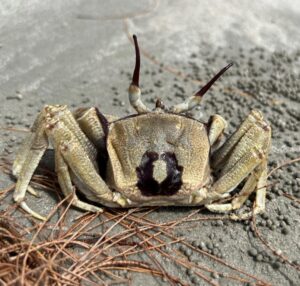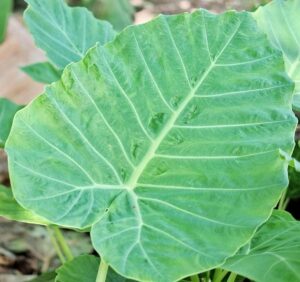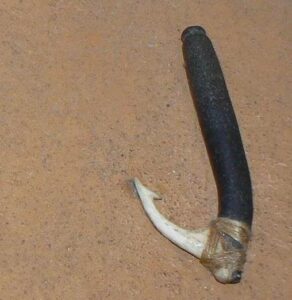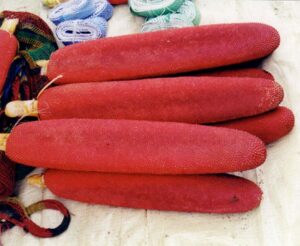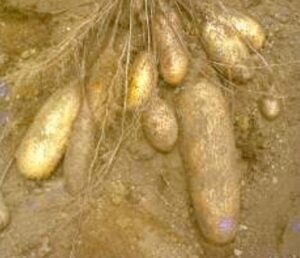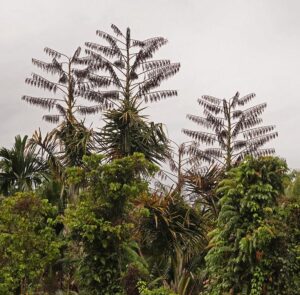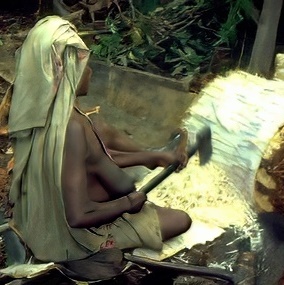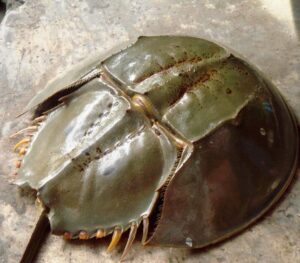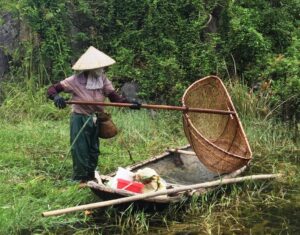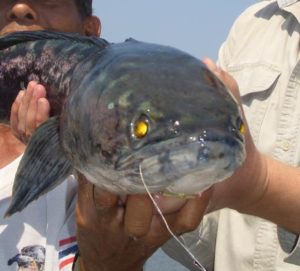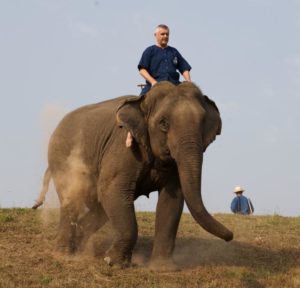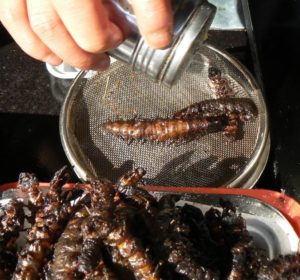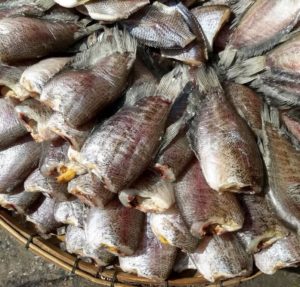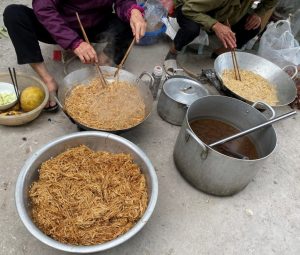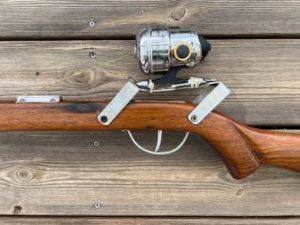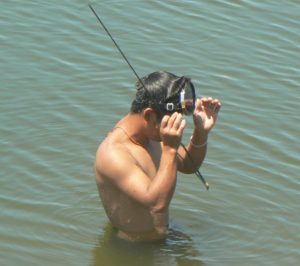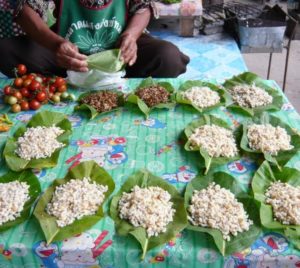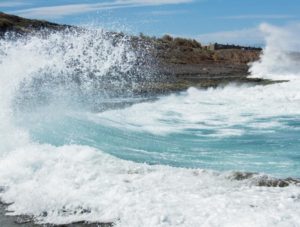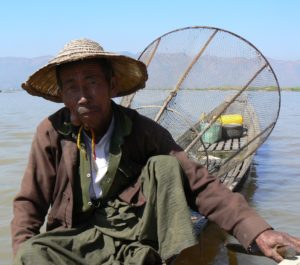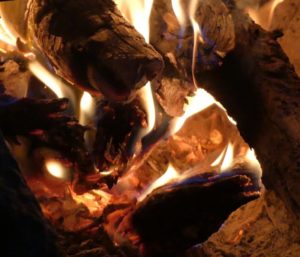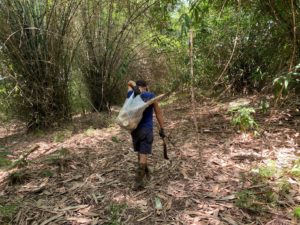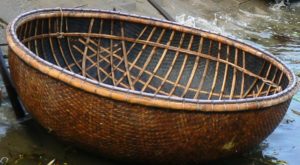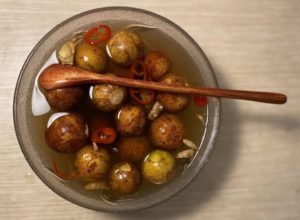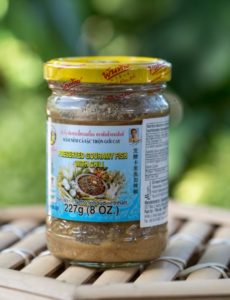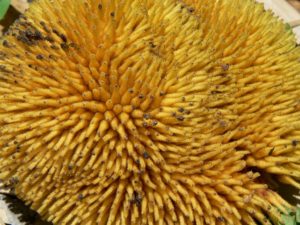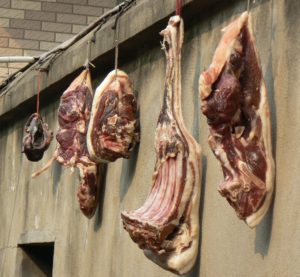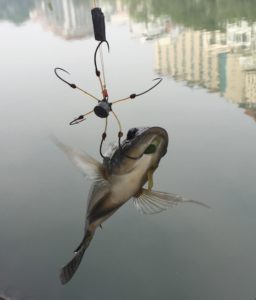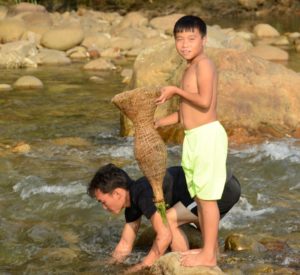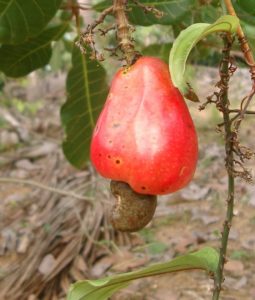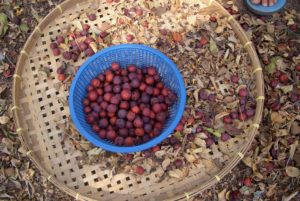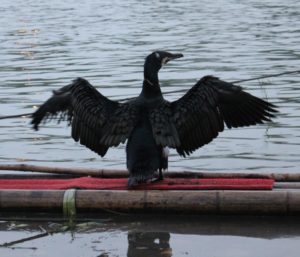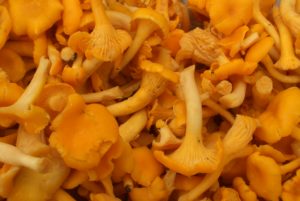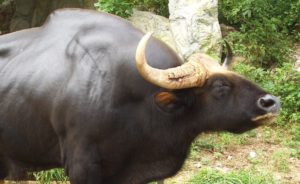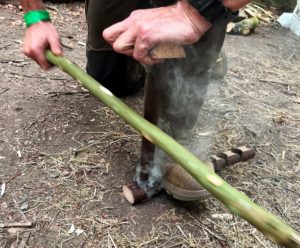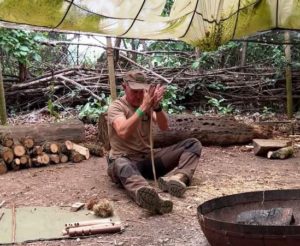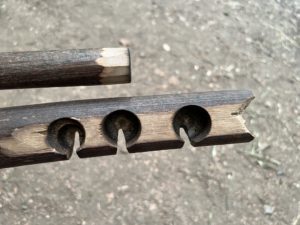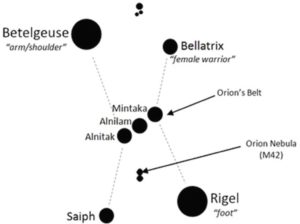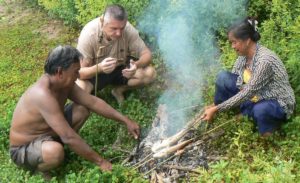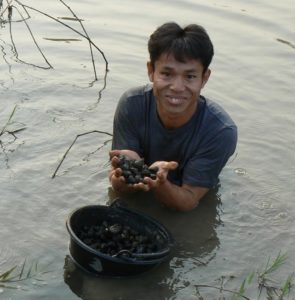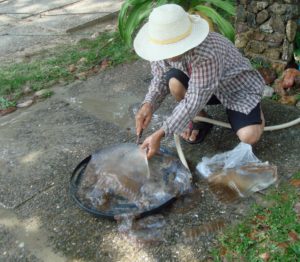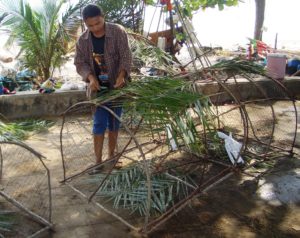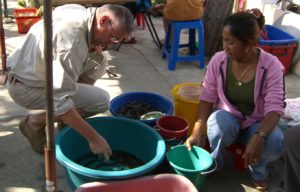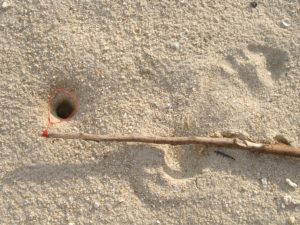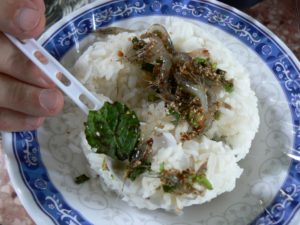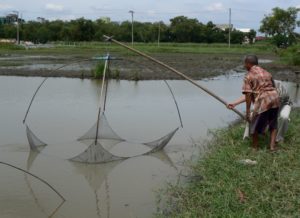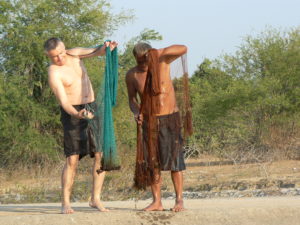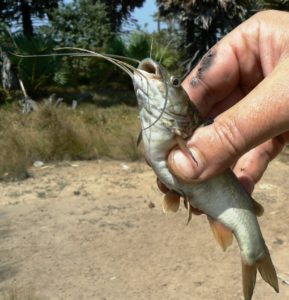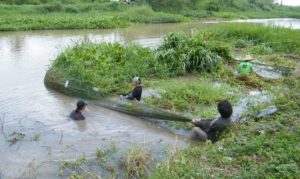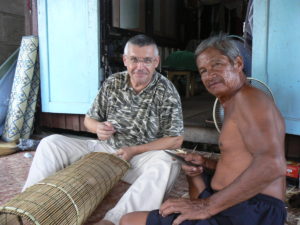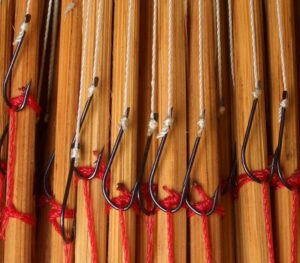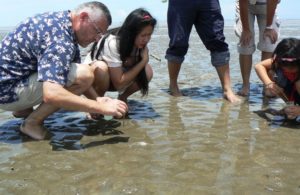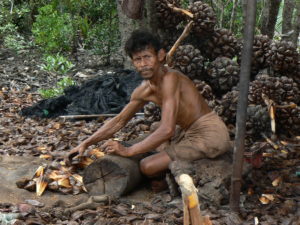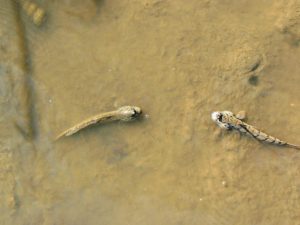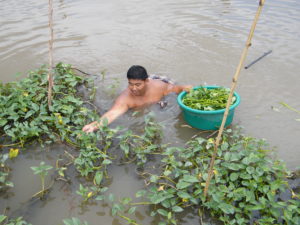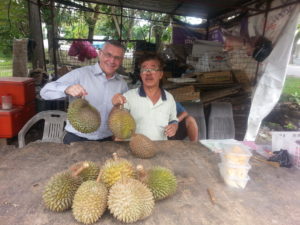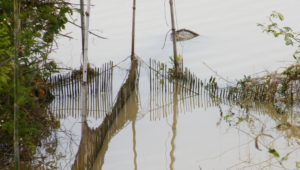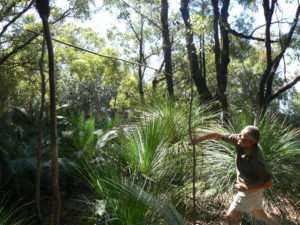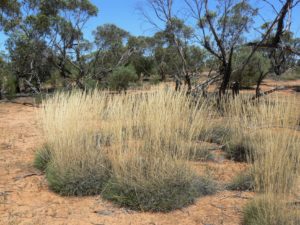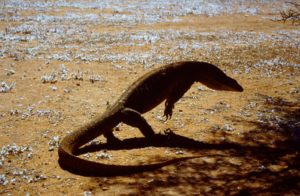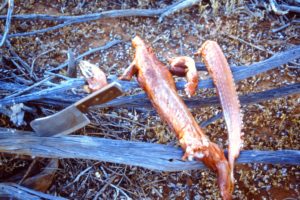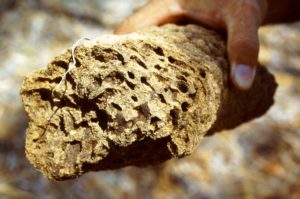Asia-Pacific
Mentawai spears
When hunting with a pack of dogs for deer, wild boars, or monkeys, three types of weapons can be used to finish off the cornered game. One is a bow and arrow, which, however, is not safe for dogs during…
Mollusks in the inland waters of Siberut Island
In rivers, coastal zones, and mangrove forests, a diverse array of bivalve and gastropod species is collected and utilized for food. Bivalvia species Freshwater streams River clams (Batissa violacea) occur in large quantities in the lower zones of all slow-flowing…
Bamboo: The Orang Asli’s natural toolkit
If rattan is the skeleton of Orang Asli junglecraft, bamboo is the toolkit. From riverbanks to misty hill slopes, clusters of bamboo mark places where people have worked, cooked, travelled, and sheltered for countless generations. To an untrained eye, most…
Soapbush – a versatile junglecraft plant
Soapbush (Miconia crenata) is also called Koster’s curse, or, due to its former scientific name (Clidemia hirta), Hairy clidemia in English. It is a highly invasive plant in tropical climates, and many countries have developed eradication programs against this weed….
Rattan: Flexible raw material from the forests
Deep in the lowland dipterocarp forests of Peninsular Malaysia, long before you see rattan, you feel it. Hooks catch on shirt sleeves, flagella tug gently at your backpack, and the forest floor is littered with the thorny sheaths of climbing…
Hand-made fishing hooks from Bali
While travelling to the northern coast of Bali/Indonesia, we met the owner of a general store at the Banyuasri Singaraja Market, whose employee was hammering fishing hooks on a makeshift anvil outside. The owner, Pak (Mr.) Gede Suarka, nicknamed “Lolak,”…
Operation of conch traplines for octopuses
In the following, we will describe the catching operation of octopuses from a fishing vessel with the help of conch traplines. This is the high-end operation of catching these cephalopods, and, based on catching weight, the primary one. But the…
Conch shells for catching Marbled octopuses
Marbled octopuses like to hide in small caves at the seafloor. Fisherfolk use this behavior and offer artificial caves, which they populate. Even while retrieving, the octopuses will not leave their shelter and can be easily caught. Since ancient times,…
Collecting honey from Dammar bees in Sri Lanka
The Rock Vedda people at Rathugala near Gal Oya in Sri Lanka collect honey from stingless Dammar bees. This last remaining band of Rock Veddas in Sri Lanka consists of 68 families, of which only ten of them still live…
Jengkol seeds
Jengkol (Archidendron jiringa) is a tropical tree that grows up to 20 meters high in the rainforests of Southeast Asia. The seeds are mainly eaten in Indonesia, but also in Malaysia, Thailand, Cambodia, and Myanmar. These seeds are called stink…
Improvised firearms of the Orang Rimba people
Improvised firearms are the new hunting weapon of choice for the wild living Orang Rimba people in Jambi province, Indonesia. In one of the following articles, I will present their traditional hunting techniques and typical hunting weapons. Here, I will…
Dangers in the Khao Sok NP in Thailand
About the Khao Sok National Park The Khao Sok National Park is located in the Surat Thani province of Thailand, and about 150 km north of Phuket in a straight line. Cheow Lan Lake on the northern park border serves…
Orang Rimba spring pole snare traps
When we were visiting a band of primitive living Orang Rimba (Kubu) people in Jambi province, Sumatra, Indonesia, each of their shelters had a spring pole snare trap nearby, which was set when they left for a walkabout. The working…
Jungle footwear for Southeast Asia, Part 3
As the topic of jungle footwear is quite an extensive one, it was split up into three articles. The first part covered general requirements, including going barefoot and wearing sandals. The second part covered shoes, including barefoot shoes, rubber shoes,…
Jungle footwear for Southeast Asia, Part 2
As the topic of jungle footwear is quite an extensive one, it was split up into three articles. The first part covered general requirements, including going barefoot and wearing sandals. This second part covers shoes, including barefoot shoes, rubber shoes,…
Jungle footwear for Southeast Asia, Part 1
In the remaining jungles of Southeast Asia, suitable footwear is of utmost importance for local people and outsiders. The rainforest environment has specific requirements that differ considerably from those of other biomes. However, the suggested footwear not only depends on…
Cooking rice in a bamboo
Bamboo is a highly versatile plant that can be used for various applications, including cooking rice in sections of its culms. Near Gerak, in Perak State, Malaysia, I met a street vendor who was traditionally cooking rice. Similar vendors can…
Wild yam in Perak’s forests
When walking with Orang Asli people from the Jahai tribe in the forests near the Royal Belum State Park in Perak, Malaysia, they showed me their traditional favorite staple food source: wild yam tubers. These tubers can be eaten without…
Building the sidewalls of simple Jahai huts
Jahai huts, characteristic of the Semang Orang Asli people, exemplify the widespread use of bamboo as a material for floors and sidewalls. The Jahai people settle in and near the area of the Royal Belum State Park in Perak, Malaysia,…
Red torch ginger fruits
Red torch ginger (Etlingera elatior) fruits are commonly eaten by Jahai Orang Asli people in the forests of the northern State of Perak in Malaysia. These fruits are not only consumed by the forest dwellers of Perak State, but also…
Harvesting rattan palm hearts
When walking with Jahai Orang Asli people near the Royal Belum State Park in Perak, Malaysia, they showed me some of their plant food sources in the forests. One of them was young rattan palm shoots. For the Jahai people,…
Rattan palm fruits in Perak’s jungles
Rattan palm fruits are available from most of the 70 species of the Calamus genus in Malaysia. But also species of Daemonorps and Korthalsia rattan genera often carry edible fruits. We went with the Jahai Orang Asli people into the…
Wild ginger stalks for food
When walking with the Orang Asli people of the Jahai tribe near the Royal Belum State Park in northern Malaysia, they showed me various edible plants in the rainforest that they ate regularly. One of them was a Zingiberaceae (Ginger)…
Stilt fishing in Sri Lanka
Stilt fishing, locally known as ‘Riti Panna’, was an essential and unique fishing technique on the southern coast of Sri Lanka between World War II and the 2004 tsunami. After this period, this coast was developed into a major tourist…
Moon mushrooms at the Royal Belum State Park in Malaysia
Moon mushrooms (Gymnopus sp.) are one group of edible mushrooms found in the forests of Malaysia, and are locally called ‘Jamur bulan’. The other groups of edible mushrooms are colloquially known as wood ear mushrooms, oyster mushrooms, and shiitake mushrooms….
Fruits eaten by Mentawai people
The fruits eaten by Mentawai people in the forests are various species of bananas, coconuts, durians, and fruits from the rattan palm. Other fruits are also harvested, of which some grow wild, while others are planted and cultivated. Fruits are…
Vegetables eaten by Mentawai people
Cassava (Manihot utilissima) leaves and Fiddlehead ferns are the most essential vegetables for the Mentawai people living in the forests of Siberut Island. Both vegetables were discussed in separate articles on this webpage. Details about Cassava leaves can be found…
Freshwater fishing at Siberut Island
Depending on the location of the longhouse of a Mentawai family, fishing is conducted in any permanent water structure large enough to hold fish, gastropods, or crustaceans. In general, fishing is regarded as the work of men; women fish only…
Carbohydrate food sources of Mentawai
Three of the four most essential food plants for Mentawai people on Siberut Island in Indonesia are carbohydrate sources. Notably, sago is a key provider, with an average composition of approximately 94% carbohydrates, about 7% moisture, and negligible other components….
Snakes on Siberut Island
Bites from venomous snake species appear to be the highest concern when walking in the Siberut forests. There are anecdotal reports that middle-aged Mentawai men were bitten by pit vipers three or four times in their lives. Non-Venomous Snakes (Harmless…
Shrimp pit traps on Sri Lanka’s east coast
Fish, crabs, and shrimp provide the livelihood of small-scale and artisanal fishermen on the east coast of Sri Lanka. Due to specific local conditions, various fishing and gathering techniques have evolved, including the use of shrimp pit traps. Tidal situation…
Gathering of Venus clams by finger probing
Venus clams (Meretrix meretrix), correctly named ‘Asiatic hard clams’, are one of Thailand’s most sought-after clams for food. They occur both in the Gulf of Thailand and on the coasts of the Andaman Sea. Fully grown species are large; their…
Vedda flint & steel fire making
Village and Rock Veddas have used flint and steel to produce fires since the end of the 19th century. My former article about Vedda fire drills explains these two different Vedda types. Village Veddas have used this fire-making procedure since…
Vedda fire drills
Until the end of the 19th century, the Vedda people in Sri Lanka used fire drills as their standard fire-making method. In the literature of that time, Vedda was spelled Veddah, and Sri Lanka was called Ceylon. Current situation of…
Feral donkey trails leading to water
At the end of the 19th and beginning of the 20th centuries, many draught animals were released in the wild in Western Australia, as motor vehicles took over their work. These included donkeys and camels. Both species flourished thereafter in…
Smoked oysters from the rocks
In the spring of 2025, I traveled to Western Australia to document local survival techniques used by Indigenous people. Across Australia, Indigenous groups are generally categorized into three main types: the so-called ‘Saltwater mobs,’ who live along the coast; the…
Bamboo rat for dinner
Bamboo rats are a common rodent in bamboo thickets in mountainous areas of northern Vietnam. Hmong tribal people in remote regions still hunt them regularly for food. Although hunting bamboo rats is officially prohibited, the practice is still widespread. To…
Creating fire with a magnifying glass
A magnifying glass has been used to start fires since ancient times. Greek and Roman writers recorded the use of ‘Burning glasses’ for domestic and war purposes. A concise history of these applications can be found on Wikipedia. Nowadays, fires…
An oyster species growing on Mangrove trees
Mangrove oysters (Isognomon ephippium) are the species most commonly found growing on mangrove trees in Northern Australia. Its other common English name is ‘Saddle tree oyster.’ These oysters are one species eagerly collected and eaten by Bardi people at the…
Edible Ferns of Papua New Guinea
Some times ferns are eaten in large quantities. At highland pig kills, ferns are one of the most common edible greens. Some ferns are only eaten with meat. Some other ferns are eaten more regularly and are very much liked….
Origin of Bananas
Most areas of Papua New Guinea have bananas. Some people have them as their main staple food while in other areas they are just a snack food. There is a very large amount of variation within the banana varieties in…
Orang Rimba shelters in the forests of Sumatra
Orang Rimba (locally called Kubu) shelters and dwellings in the forests are designed in different styles rooted in their semi-nomadic lifestyle. These structures can be divided into two main groups: semi-permanent structures and shelters when they are on the move….
Tu-Lip trees in Papua New Guinea
Tok Pisin: Tu lip; Scientific name: Gnetum gnemon What does a tu-lip tree look like? It is a small tree often only 8-10 metres high. It is a fairly straight tree with one trunk that has branches spread out along…
Visiting Orang Rimba people in Jambi province
Who are the Orang Rimba people? The expression ‘Orang Rimba’ means ‘People of the rainforest,’ but this name is primarily used by scientists internationally. In Indonesia, the people call them ‘Kubus,’ which means being outside or on the fringe of…
Collecting honey in a rock crevice
Asian honey bees and their combs are a special treat for the local population of backcountry areas at Pu Luong Nature Reserve in northern Vietnam. The harvested honey is seldom sold and is mainly used by the villagers. The grubs,…
Harvesting Shipworms in a Thai Mangrove Forest
Edible shipworms, in this case Bactronophorus thoracites, are also known as Naked clams, Priyang talay (เพรียงทะเล), and various other common names throughout the region where they occur. They bore into wood immersed in salt water and are a major hassle…
Disinfecting water with Potassium Permanganate
Potassium permanganate is an essential chemical for various simple living applications. One is its disinfecting effects, and the other is the possibility of chemically starting fires. This article discusses disinfecting water on a small scale for drinking purposes. We will…
Collecting Pipi clams at Rawai Beach
Pipi clams (Donax deltoides) are also known as Surf clams, Sandy Donax, and a wide range of other common names. In Thailand, they can be found on most beaches in the Gulf of Thailand and the Andaman Sea. They are…
Bottom fish traps of the Urak Lawoi people
The following information was gathered from a Urak Lawoi man who has lived in the Rawai Beach Sea-Gypsy Village for 27 years. He was 57 years old and only had one tooth (incisor) left in the middle of his upper…
Rectangular squid traps in Thailand
Rectangular squid traps are used in the Gulf of Thailand and along the coastline of the Andaman Sea in the same way as semi-circular traps. Both types are used mainly for catching Bigfin reef squid (Sepioteuthis lessoniana) but will also…
Catching mud crabs at Koh Lanta
Mud crabs are common in mangrove areas in Thailand. They are primarily caught in crab pots for commercial purposes. However, my Urak Lawoi friends and I specialized in digging up and catching these crabs by hand. Who are Urak Lawoi…
Ambarella fruit in the Mekong Delta
Ambarella fruit (Spondias dulcis Parkinson; syn.: Spondias cytherea) is native to Melanesia and Polynesia and was introduced worldwide throughout the tropics. Its other common English names are Jew plum and Golden apple. In the Mekong Delta, it is omnipresent in…
Trapping eels in Northern Vietnam
Trapping eels is a simple way for rice farmers in the catchment area of the Red River in North Vietnam to provide themselves with animal protein. No special skills are required, as with angling or net fishing. The activity is…
Edible rock snails in limestone areas of Vietnam
Rock snails of the genus Cyclophorus are highly sought-after wild foods in rocky limestone mountain areas of Vietnam. These snails are not only regarded as food but also as medicine against various ailments. The local Vietnamese name is Ốc thuốc,…
Blowpipe hunting with Orang Asli people in Malaysia
Blowpipe hunting is still prevalent in many Orang Asli communities in Malaysia. Although the government strictly enforces hunting rules and regulations, it is practically impossible to supervise all the remote small hamlets and villages. On the other hand, it is…
Collecting Bibi worms on Koh Lanta
Bibi worms (Sipunculus nudus Linnaeus, 1776) belong to the Peanut worm phylum. They can be dug up at the intertidal zone of flat, sandy beaches on temperate and tropical beaches. These worms are primarily used as top fishing bait. At…
Ginger flowers add zest to food
Ginger flowers are eaten in many Southeast-Asian cultures. In Indonesia, most ginger varieties are known from Siberut Island. The native population of this island has utilized the flowers of Torch Ginger (Etlingera elatior (Jack) R.M. Sm.) since ancient times for…
Young Cassava Leaves provide protein and micronutrients
Young cassava leaves are a regularly eaten side dish for Mentawai people. Cassava (Manihot esculenta, Crantz) is endemic to the southern rim of Amazonia in South America. There, it was domesticated around 5000 BC. In the 16th century AC, Spanish…
Vegetable ferns are a source of nutrients in Siberut
Vegetable ferns (Diplazium esculentum (Retz.)) are among the few wild vegetables Mentawai people in the forests eat regularly on Siberut Island. By Mentawais, they are called ‘Laipat.’ Other wild vegetables are cassava leaves, ginger flowers, taro stalks, and wild eggplants….
Scissor Traps of Thái Đen tribals in Vietnam
Scissor traps are universal traps that can catch all kinds of small rodents. They are easy to produce from bamboo but need one item to be sourced in the villages. These are strips of bicycle tubes, which are not easy…
Bow Traps of Thái Đen tribals in Vietnam
Bow traps are used by Black Thai tribal people in Northern Vietnam to catch small rodents. These ingenious devices are carved from pieces of bamboo and some strings. The closing force of the scissor comes from a bow-like structure above…
Domestic pigs as food by Mentawais
Domestic pigs are a typical gift from a Mentawai family to a shaman for his support or services. In our case, Aman Aru attended a ceremony in a neighboring Uma (family home in the forests), which had to be cleaned…
Deadfall Traps of Thái Đen tribals in Vietnam
Deadfall traps with a Figure-4 trigger are essential knowledge for survivalists and bushcrafters worldwide. Thái Đen (Black Thai) tribal people at Pù Luông Nature Reserve in Northern Vietnam use these traps and the Figure-4 trigger in a modified version. Modifications…
Mentawai forest huts
The Mentawai people at Siberut Island use forest huts (called Sapou by them) for various reasons and purposes. One is a permanent dwelling for single, old men who do not live with their family in the Uma (family home in…
Rattan fruits in Siberut jungles
Rattan fruits are available throughout the year in all Southeast Asian rainforests. There are about 600 different species of rattans, and many of them bear edible fruits. However, rattan prickles are a common nuisance when walking in the jungle. Nevertheless,…
Carrying baskets of Mentawai people
Mentawai people use five types of carrying baskets, which they call Opa, Tuku, Jarakjak, O’orek, and Bolokbok. Opa – the standard-sized carrying baskets. Opa are the most popular type of carrying baskets. They are entirely woven from Calamus javensis rattan vines collected from…
Cutting- and chopping tools at Siberut Island
The cutting- and chopping tools used by forest dwellers include adzes, axes, machetes, and a specialized knife. All of these tools have a strong historical background and are still in use today. Axes People primarily use axes (Oggut) to fell…
Sago worms of an unidentified species at Siberut Island
Sago worms are one of the food items that come naturally with the Mentawai’s staple food, sago flour. The worms grow in felled palm trunks or saplings. They are not worms but larvae and pupae of the Palm Weevil beetles…
Mentawai Shamanic Rituals: The Role of Sacrificial Chicken in Siberut Culture
Deep in the rainforests of Siberut Island, the Mentawai tribe food culture transcends simple nutrition, weaving a complex web between the physical world and the spirit realm. While their diet is traditionally rooted in sago and forest foraging, the domestic…
The Use of Rattan Leaf Stalks as Coconut Graters in Mentawai Culture
Rattan leaf stalks have been, since immortal times, the tools with which Mentawai people have been grating coconuts. These long-lasting tools grate the coconuts into the required size of flakes. When worn out or broken, a new one will be…
Taro – another staple food of the Mentawai people
Taro (Colocasia esculenta (L.) Schott) is one of the three staple food items of the Mentawai people on Siberut Island in Indonesia. The other two are sago and bananas. In many other countries, taro leaves and corms are eaten. Mentawais…
Roasted Sago sticks on Siberut Island
Roasted sago starch is the staple food for Mentawai people living in the moist, tropical forests of Siberut Island, off the coast of Western Sumatra in Indonesia. On the other hand, sago, boiled to porridge, is eaten as a staple…
White Ginger Lily for cleaning hands
White Ginger Lily (Hedychium coronarium J. Koenig) belongs to the Zingiberaceae (Ginger) botanical family. Mentawai people use the crushed stem to clean their hands after touching arrow poison or one of its two poisonous main constituents. In another article on…
Danger of Asian elephants – whether they are in musth or not
Asian elephants (Elaphas maximus) are smaller than their African cousins but not less dangerous when in musth. That danger was already described for African elephants in this article on this website. In the following, we briefly compare the differences between…
Mentawai arrow poison
The Mentawai people use poison on their arrows to hunt game. In previous articles on this website, we discussed the Mentawai people’s hunting methods. Then, we presented an actual hunt for Flying foxes. We then discussed the longbows used on…
Hunting arrows and quivers of the Mentawai people
Bows and arrows are the primary hunting weapons used by the Mentawai people. Their bows were already described here. This article will explain the different types of arrows used for these bows and give an insight into the quivers used….
Mangrove apples at the Mekong Delta
Mangrove apples are the fruits of Sonneratia sp. trees, one of the important genera of trees in the Mangrove forests of Southeast Asia. All species of Sonneratia will develop edible Mangrove apples. The various Sonneratia species differ slightly in shape,…
Animal species collected by rice farmers in the Red River Delta
Rice farmers in secluded areas of the Red River Delta in Northern Vietnam need dietary additions to their staple rice dishes. Vegetables are harvested from around their homes and surrounding tropical Evergreen forests. Animal proteins are mainly collected in and…
Natural shampoo from a Soap plant (Gouania leptostachya)
Natural shampoo can be extracted from a variety of plants worldwide. In the evergreen forests of Lowland in Northern Vietnam, we used the leaves of a so-called soap plant. With these leaves, we regularly washed our hands and bodies. In…
Building a specialized fishing boat at Padang
In Indonesia, there is a wide variety of traditional fishing boat designs. Most of them are variations of standard types adapted to local needs and conditions, and many of them have not been systematically described yet. This article presents one…
Stinging Nettle Slug Caterpillar in Vietnam
When hiking in Pu Luong Nature Reserve in northern Vietnam, we found a species of Stinging Nettle Slug Caterpillar on a Banana leaf. My local friends got highly nervous when they saw it, and I was intensely warned against touching…
Boiling water in bamboo
Boiling water in green bamboo stems (‘culms’ would be the botanically correct term) is not a significant skill, but it represents the basic cooking technique in Southeast Asian forests. One of the following articles will build on that and explain…
Trapping Snakeskin Gourami in the Mekong Delta
Trapping Snakeskin Gourami fish (Trichopodus pectoralis) is commonly done all over Southeast Asia. However, a specific trap for catching them was developed in the Mekong Delta in Vietnam. Its simple principle could be easily applied to many other areas of…
Green-billed Malkoha bird on the spit
The Green-billed Malkoha is a common bird in Vietnam’s semi-deciduous tropical forests. An expedition led to the capture of one who was cooked for lunch. This and other species are often hunted by villagers supplementing their diet with this and…
Catching Octopuses by Sea-Gypsies
Sea-Gypsies – Urak Lawoi, Moklen, and Moken – traditionally catch octopuses along the Andaman Sea’s rocky shores, which they call โวยวาย in the Thai language. Using a metal skewer and baited bamboo stick, they locate octopuses in holes with foam…
Mentawai Hunting bows
Hunting bows are the primary hunting weapon for the Mentawai people and are very personal items for a hunter. They have excellent skills in using them and practice shooting from childhood onwards. During my stay with the Mentawais, I looked…
Flying fox hunting
Flying fox hunting remains a prevalent activity in Indonesia, particularly in Sumatra. Aceh, the northernmost province, is the epicenter of the trade in Flying fox meat. Locals believe that this meat possesses qualities to alleviate asthma, although this claim lacks…
Hunting methods of Mentawai people
The hunting methods of the Mentawai people have developed over about 3000 years. Their ancestors were of a Mongolian race that migrated from Taiwan via the Philippines to modern-day Indonesia. They arrived around 1000 BC at Siberut island in West…
What is Fongaar? The Tropical Tuber That’s Part Sweet Potato, Part Yam.
Scientific name: Ipomoea macrantha Roemer & Schultes; Synonyms: Ipomoea tuba (Schlechtend.) G. Don; Plant family: Convolvulaceae; Tok ples: Fongaar What is the plant like? The plant has a long angular vine 5 to 6 metres long and it climbs up…
How Mentawai people assemble roof thatching panels
Roof thatching is vital for shelter waterproofing in the Mentawai tribe, which has around 6,000 members, on Siberut Island, Indonesia. Siberut lies about 100 miles (160 km) west of Padang in West Sumatra. Of the 6,000 Mentawai people, roughly 1,000,…
Pitpit – Edible grasses in Papua New Guinea
Three types of pitpit grow in Papua New Guinea: Coastal pitpit The pitpit plant looks like sugarcane to which it is related. Normally the stalk is thinner than sugarcane. It can grow up to 3 metres high and produces suckers…
Wild Karuka and another pandanus fruit species
The Pandanaceae botanical family comprises the following six species in Papua New Guinea: ‘Karuka’ and ‘Marita’ were already discussed on this website in two former articles. ‘Karuka’, see here, and ‘Marita’ see there. In the following, ‘Wild Karuka’ and Pandanus…
Karuka – cultivated pandanus fruits and nuts
Tok Pisin: Karuka Scientific name: Pandanus jiulianettii Two species of pandanus are commonly used for the nuts that are eaten. They are Karuka (Pandanus jiulianettii Martelli) and wild Karuka (Pandanus brosimos Merr & Perry). At least 3 other species of…
Catching Ghost crabs by digging
Ghost crabs (genus Ocypode) comprise 22 different species, and they are commonly also called `Sand crabs.` The scientific name Ocypode has Greek origin and means swift-footed. Ghost crabs are semi-terrestrial crabs that dig deep burrows in intertidal zones of sand. They…
Giant Taro – a plant with a giant root
English: Giant taro; Scientific name: Alocasia macrorrhiza (L.) Schott; Synonyms: Alocasia indica (Lour.) Spach; Plant family: Araceae Description of Giant Taro plants A very large herb of the taro family. It has a stout erect trunk up to 4 m…
Neolithic fishhooks in Korea
During the Neolithic Age (8000 BCE—1400 BCE), people across various regions began to adapt to the evolving natural environment following the Ice Age. This era is characterized by the emergence of earthenware artifacts and groundstone tools and the establishment of…
Marita – a lesser known pandanus fruit
English names: Marita or ‘Red Fruit’ Tok pisin name: Marita Bahasa Indonesia name: Buah Merah Scientific name: Pandanus conoideus Lamarck The marita pandanus plant A short much branched screw pine with many prop roots. The prop roots have prickles. Trees…
Yam varieties in Papua New Guinea
Four species of yam are commonly grown and used for food in Papua New Guinea – but often naming in villages and naming by scientists do not agree. Many village people regard potato yam and 5-leaflet yam as varieties of…
Solomon’s Sago – another Sago palm species
How is this sago different? The Solomon’s sago palm that occurs in the North Solomon province and the Solomon Islands is quite different from the sago that grows in other areas of Papua New Guinea. It has a different scientific…
Sago – staple food in parts of Papua New Guinea
There are two Sago palm species in Papua New Guinea. Metroxylon sagu Rottb. and the other one occurs in North Solomons Province and the Solomon Islands. Its scientific name is Metroxylon salomonense. The sago palm plant The sago palm grows…
Utilizing Horseshoe Crabs as a Food Source
Foreword Horseshoe crabs are a species not protected in Thailand and are experiencing a significant decline. Their primary habitats, particularly the mudflats around mangrove forests, where they live and reproduce, are diminishing, and there is a growing demand for edible…
Using a stomping basket to catch fish in Vietnam
Fishing with a stomping basket has been a traditional craft in Vietnam for centuries. Postcards from the French colonial era depict this unique fishing method as a typical way for locals to catch fish. While similar techniques exist in other…
Giant Snakehead fishing in Thailand
The Giant Snakehead fish (Channa micropeltes) is a highly aggressive and predatory freshwater fish. Its diet mainly consists of smaller fish, frogs, crustaceans, and aquatic prey. In Malaysia, Singapore, and Indonesia, this fish is known as the ‘Toman’ and, along…
Mahout training at Lampang province
The National Elephant Institute of the Forest Industry Organization of Thailand conducted mahout training for amateurs near Lampang. This institute was initially established as a training center for elephants working in the timber industry, where they learned how to lift,…
Eating centipedes in Yunnan Province, China
Eating insects and centipedes is a long tradition in Lijiang City, in Yunnan Province, P.R. China. In addition to centipedes, other insects such as bamboo worms, silkworm pupae, and locusts are also consumed. While they are high in protein and…
Semi-Dried Fish in Thailand
In Thailand, both sea and freshwater fish are dried to increase their shelf life for later human consumption. Before the advent of refrigeration, the primary method for preventing spoilage was to salt the fish and then leave it in the…
Canh Măng Mực: The Royal Dried Squid and Bamboo Soup of Bát Tràng
Experience the sophisticated flavors of Northern Vietnam with Canh Măng Mực, a rare, traditional Vietnamese squid-and-bamboo soup. Deeply rooted in the culinary heritage of the ancient Bát Tràng ceramic village near Hanoi, this dish is far more than a simple…
Description of a speargun for freshwater fishing
In the following, we will briefly describe a specific speargun for freshwater fishing, which I bought from a fisherman in the northern suburbs of Bangkok, Thailand. It is neither as primitive as many of these guns are, nor is it…
Mechanically propelled darts for freshwater fishing
Mechanically propelled darts for freshwater fishing are commonly used all over Thailand. Many craft these devices themselves, so there is a wide variety of principles, styles, and designs. Besides homemade spearguns, where every piece is unique, industrial manufacturing is also…
Weaver ants got interesting traits
Weaver ants of the genus Oecophylla consist of two different species. One species is Oecophylla longinoda, which occurs in equatorial, tropical African regions. The other species is Oecophylla smaragdina, distributed in tropical Asia and Australia. Both of them are also…
Australian Firesaws
Firesaws are only known as a traditional fire-making method on the Pacific Islands. In Australia, these methods were replaced by friction fire hand drills and later, under Western influences, by bow drills. Nevertheless, fire sawing is an interesting technique, which…
Salt intake at seashore survival activities
The salt intake of a human in case of an actual survival situation or when living from the provisions of a shoreline by purpose is of utmost importance to its health. If too much salt is consumed, the body has…
Traditional fishing at Inle lake in Myanmar
Traditional fishing at Inle Lake is endemic and specific to this local environment. Inle Lake is the second largest lake in Myanmar, approximately 50 square miles (abt. 116 km2). During the dry season, the average water depth is only 7…
The Evolution of Fire
The history of fire is fundamentally the history of humanity itself. Long before our ancestors learned to create a flame, fire was a terrifying natural force—a byproduct of lightning strikes that brought both destruction and opportunity. However, the transition from…
Bamboo shoot harvesting at the Red River
With more than 70 bamboo species throughout the country, we can easily find bamboo thickets anywhere in Vietnam. Many could nurture one of the most popular and favored vegetarian foods for Vietnamese people, bamboo shoot harvesting. Two main types of…
Coracles at Duy Hải, near Hoi An, Vietnam
Hoi An is located about 35 km south of Da Nang, which is roughly in the middle of mainland Vietnam. It is one of Vietnam’s most picturesque towns and attracts many tourists. Which in turn requires lots of fish and…
Indochina Dragon Plums from Hanoi streets
The Indochina Dragon Plum (Dracontomelon duperreanum) is a genus of flowering plants in the family Anacardiaceae. In Vietnamese, it is called chi sấu). Dragon Plums are one of the most popular trees on the side of Hanoi streets. The fruits…
Pla Ra – Thailand’s fermented fish condiment
Pla Ra (Thai: ปลาร้า, pronounced [plāː ráː]), is fermented fish. Traditionally, Thais in the Central and Northeast provinces (Isan) eat fish and rice. In these relatively poor provinces, there is only one rice growing cycle every year. The planting season…
Marang fruits in Southeast-Asian Rainforests
There are several local names for the tree and fruits of Artocarpus odoratissimus. In English, it is simply called ‘Marang’, which is based on the Philippines’ common name for this fruit. Originally endemic to the region around Mindanao, Sarawak, Kalimantan,…
Drying meat in Shanghai at wintertime
It is at least a 2000-year-old tradition in many provinces in China to cure and preserve meat in wintertime. Pigs were slaughtered after the ‘Light Snowfall’ date (around Nov 22nd/23rd). Then, the temperatures plummeted, and this meat had to be…
Fish ripping in Hanoi, Vietnam
A typical fishing technique in Vietnam is ripping a weighted hook with multiple side arms through still water and hoping to hook unsuspecting fish somewhere on their body. Hooking a fish at the lips with the correct size and style…
Fish trapping at a fast-flowing brook in Vietnam
Trapping fish in bamboo traps in Southeast Asia is normally a static affair. These fishing traps are used in still waters with or without bait inside and checked at least once daily. It was a new experience to see somebody…
Cashew apples and -nuts in Goa, India
Cashew trees (Anacardium occidentale) are native to areas around Northeastern Brazil. Portuguese colonists brought them around 1560 to Goa, India, from where they spread to Southeast Asia and Africa. Therefore, cashew products already have a long history in Goa and…
Jujube trees at Ayutthaya in Thailand
The Ayutthaya Historical Park covers the ruins of the old city, which was founded by the Khmer in 850 AD and named after the Hindu holy city of Ajodhya. The city was destroyed by the Burmese in 1767 and has…
Cormorant fishing at Li Jiang River in China
Cormorant fishing is an ancient art that dates back at least 1300 years. Today, it is only practiced in the southwestern provinces of China. However, some fishermen are attempting to revive this fishing technique for tourists in water villages around…
Chanterelle mushrooms in Thailand
Thai chanterelles, specifically Cantharellus minor, live in symbiosis with Gurjun trees (Dipterocarpus tuberculatus) in semi-deciduous Southeast-Asian forests. These trees are easily identified due to their double-winged (di-ptero) fruits with big seeds. Besides Cantharellus minor, other species of chanterelle mushrooms are…
Taste of Gaur meat at Kaeng Krachan rainforest
We were on a weeklong trail through the Kaeng Krachan rainforest, near Hua Hin in Thailand, when we tasted Gaur meat. Together with two National Park (NP) rangers, we came across a freshly died Gaur heifer. This Gaur (Bos gaurus)…
Bow drilling in Australia by Gordon Dedman
At the Global Bushcraft Symposium 2022 in the UK, Gordon Dedman presented the bow drilling technique he teaches in Australia. Since readers are assumed to know the basics of bow drill friction fire lighting, I will only concentrate on specific…
Hand drill friction fire lighting in Australia
At the Global Bushcraft Symposium 2022 in the UK, Gordon Dedman presented the hand drill friction fire lighting method he teaches in Australia. As most readers of this topic will know the basic techniques of hand drill friction fire lighting,…
Australian friction-fire woods
At the Global Bushcraft Symposium 2022 in the UK, Gordon Dedman presented a variety of types of Australian friction-fire wood, which are well suited for friction-fire lighting methods and tinder. The signature friction-fire method, exclusively used for thousands of years…
Finding True South in the Southern Hemisphere
The Southern Cross, or the Constellation of Crux – as the name implies – is visible in the Southern Hemisphere. It consists of the Southern Cross and the two pointers: Alpha-(Rigil Kent) and Beta-Centauri (Hadar). Finding direction in True South…
Constellation Scorpius at the Southern sky
The Constellation of Scorpius (‘Scorpio’) is a vast constellation visible from May to November in the evening sky of the Southern Hemisphere. It is located directly opposite the Constellation of Orion – therefore, visible when Orion is not. Finding direction…
Finding direction with the Constellation of Orion
The Constellation of Orion, or ‘The Hunter’ can be best viewed in the evening skies from November to February. It holds for both the Northern and Southern hemispheres during that time. Of the three belt stars, the highest one is…
Pla Yang: Traditional Thai Open-Fire Spit Roasted Fish Guide
Grill spit for small fish outdoor cooking on a spit Smaller fish up to about 20 cm long are typically put on a grill spit, which is just a split stick. Often, in Thailand, this will be Pla Kod (Thai:…
Freshwater snails for food
In Thailand, two types of freshwater snails are commonly consumed. The first group is comprised of the larger Apple snails (Pomacea canaliculata), while the other group is referred to as Freshwater snails (Sinotaia sp. & Filopaludina sp.). These genera can…
Jellyfish for food and its preparation
Edible jellyfish (Aurelia sp.) is called ‘Maeng krapun jarn’ (Gulf of Siam) or ‘Lodchong’ (Andaman Sea) in Thailand. Usually, there are about three months a year when jellyfish appear for food. During this jellyfish run, sea fishermen earn a sizeable…
Semi-circular squid traps in Thailand
Squid is a main source of income for many fishermen in villages around the Gulf of Thailand and the Andaman Sea. Because fish are becoming increasingly rare, whereas Cephalopods maintain their population. Only certain types of finfish are sold profitably,…
Catching and holding live eels
The Asian swamp eel (Monopterus albus), called Pla Lai in Thailand, is used as a food source and for offering to the spirit deities. When still slim and young, eels are sold to the Buddhist local population for doing a…
Crab snare at Koh Samui
Simple crab snare for use on a tropical beach A crab snare is usually shaped like a bait cage with about six snares around it. This set-up combines a fishing line and rod or just hung down the sea bottom…
The Ultimate Survival Snack: Foraging and Preparing Ricefield Shrimp
Freshwater prawns, specifically Macrobrachium lanchesteri—locally known as Goong foi in Thailand—are one of the most efficient “survival foods” you can find in the wild. While they might be small, these translucent crustaceans are abundant in nearly every permanent water body…
Hand lifting net (Yor lek) in Thailand
Small lift net for catching daily meals of freshwater prawns and fish ‘Yor lek’ is a hand-lifting net; in Thai, it means something like a ‘small lift net. ‘ ‘Yor’ means ‘lift net’ and ‘lek’ means ‘small’. Its big brothers…
Cast net throwing technique
Description of cast nets used in Thailand Cast nets in Thailand are available in different radius models. I prefer one with a radius of 3.5 meters, which is from the center of the net to the outer axial rim chain,…
Small catfish got dangerous spines in Thailand
There is a variety of small catfish species with dangerous spines living in Thai waters. One, a very abundant one, is locally called Pla Kod (Hemibagrus wyckioides); English common name: Asian Redtail Catfish; Thai name: ปลากด. The typical length for…
Circumferencing water plants to catch fish
Most Thai water channels, khlongs, and streams are clogged with a variety of water plants, predominantly Common Water Hyacinth (Eichhornia crassipes). This invasive species was introduced in 1901 by Thai Royalty from Indonesia and was supposed to be eradicated by…
Crafting a bamboo fish trap in Thailand
Learning the craft of bamboo fish trap weaving The correct English wording for a ‘Lop’ in Thai would be ‘Horizontal cylinder trap with entry cone’. It is used to catch various freshwater fish and crustaceans, including small snakeheads, catfish, shrimp,…
Bank line fishing in Southeast Asia
The term ‘Bank line’ used in English to refer to a string of poles along a water bank is virtually unknown in Southeast Asia. Instead, this fishing method and its equipment are referred to by different names in the region….
Razor clams collection with quicklime
A mudflat full of razor clams ‘Don Hoi Lot’ is a mudflat in the Thai Province of Samut Songkhram with a size of about 15 km2 (about 9 square miles). ‘Don’ means ‘mudflat’ in English. ‘Hoi’ means ‘clam’, and ‘Hoi…
Harvesting and opening Nipa Palm fruits
Nipa palms (Nypa fruticans) are a species of palms especially adapted to muddy environments of slow-moving tidal waters and mangrove forests. They occur in Asia-Pacific tropical climates. Nipa palm fruits are delicious to eat. Both the fruits and wooden parts…
Mudskippers for food
In Thailand, four mudskipper species can be found. These are the Giant mudskipper (Periophthalmodon schlosseri), Blue-spotted mudskipper (Boleophthalmus boddarti), Gold-spotted mudskipper (Periophthalmus chrysospilos) and the Indian Dwarf mudskipper (Periophthalmus novemradiatus). The Giant- and Blue-spotted mudskippers live at the Andaman Sea-…
Morning glory – a valuable wild vegetable in Asia
Swamp morning glory or Water spinach (Ipomoea aquatica) has various common names, like ‘Kangkong’ in Southeast Asia or ‘Kung Shin Tsai’ in China. It is a staple vegetable food throughout the Asia-Pacific region. It is deficient in calories (19 cal/100…
Heavenly Durian
The fruit Durian (Durio zibethinus) is named after the Malay word ‘Duri’ for ‘Thorn’, referring to the thorny skin, and ‘zibethinus’ obviously refers to its smell. And the most sought-after variety in Malaysia is ‘Musang King’, where ‘Musang’ means ‘Palm…
Bamboo fence fish traps around Tonlé Sap lake
In many areas of the biggest Cambodian lake, its tributary river, and the Mekong flood plains, permanent bamboo fence fish traps, or, more appropriately, catching structures, are erected and operated. The leader fence, which guides fish into the trap’s inner…
Spear shafts from grass tree stalks
Grass trees (Xanthorrhoea sp.) and grass tree stalks are endemic to Australia. They are locally called ‘Black Boys’ due to their appearance after bushfires. They need a certain number of regular fires for their survival and are well protected against…
Spinifex grass – friend and foe
The common name ‘Spinifex grass’ is not entirely correct as a botanical term for discussed grasses, as commonly named ‘Spinifex’ grasses belong to the genus ‘Triodia’, whereas the genus ‘Spinifex’ itself contains mainly coastal grasses. Whatever it is, the common…
Spotting a magnificent sand monitor (Goanna)
Description of Goannas The Australian sand monitor (Varanus gouldii) is also called Gould’s monitor or colloquially ‘Goanna’. There are two subspecies: Varanus gouldii gouldii and Varanus gouldii flavirufus (smaller subspecies). V. gouldii gouldii is distributed nearly all over Australia except…
Eating a sand monitor lizard (Goanna)
In the former article, I described seeing a majestic sand monitor lizard close by on my drive from Menzies to Sandstone on a side road. Driving further on, I was surprised to see many more Goannas left and right on…
Ant beds for building materials in Australia
Although they are commonly referred to as “Ant beds,” particularly in Australia, the structures are actually “Termite mound.” Despite their physical similarities to ants, termites are related to cockroaches rather than ants. However, like ants, they are small and numerous….

